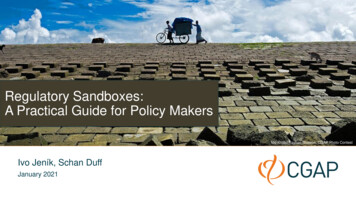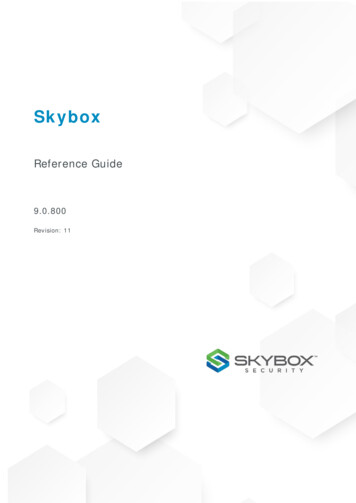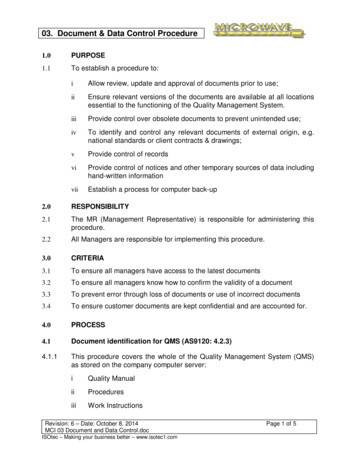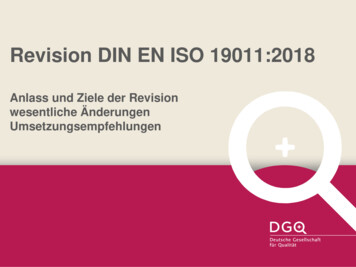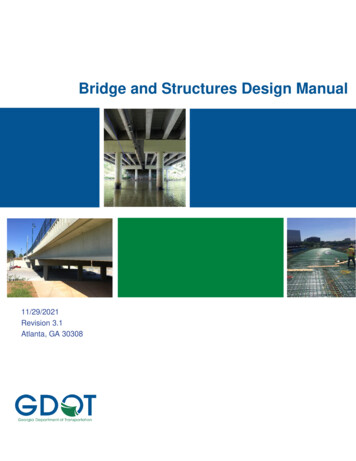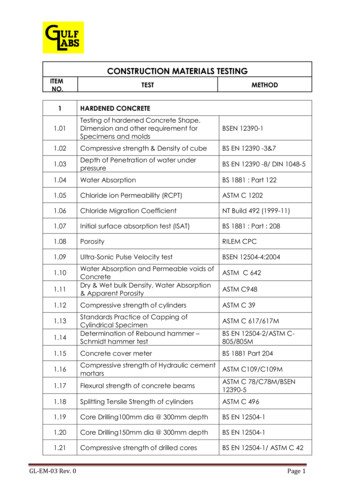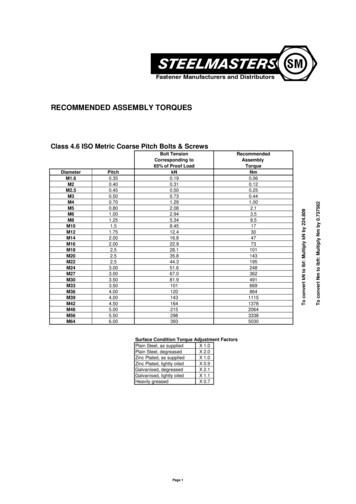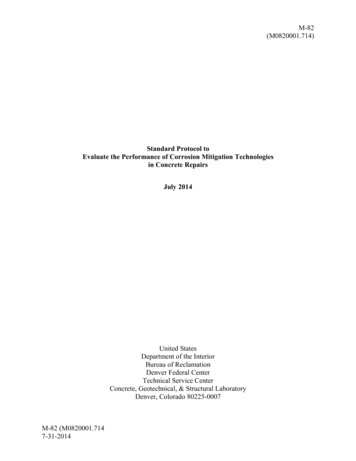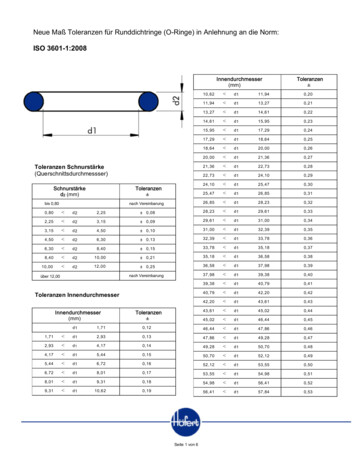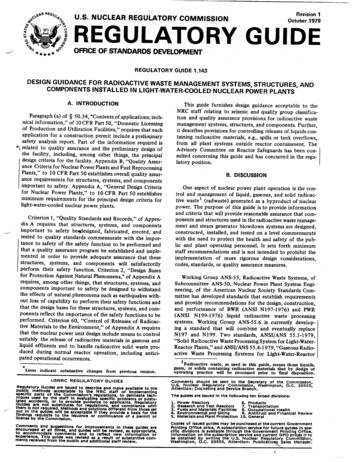
Transcription
0,11RE.&tx, tM outRevisionU.S. Octoberi1979OFFICE OF STANDARDS DEVELOPMENTREGULATORY GUIDE 1.143DESIGN GUIDANCE FOR RADIOACTIVE WASTE MANAGEMENT SYSTEMS, STRUCTURES, ANDCOMPONENTS INSTALLED IN LIGHT-WATER-COOLED NUCLEAR POWER PLANTSA. INTRODUCTIONThis guide furnishes design guidance acceptable to theNRC staff relating to seismic and quality group classification and quality assurance provisions for radioactive wastemanagement systems, structures, and components. Further,it describes provisions for controlling releases of liquids containing radioactive materials, e.g., spills or tank overflows,from all plant systems outside reactor containment. TheAdvisory Committee on Reactor Safeguards has been consulted concerning this guide and has concurred in the regulatory position.Paragraph (a) of § 50.34, "Contents of applications; technical information," of 10 CFR Part 50, "Domestic Licensingof Production and Utilization Facilities," requires that eachapplication for a construction permit include a preliminarysafety analysis report. Part of the information required is*j related to quality assurance and the preliminary design ofthe facility, including, among other things, the principaldesign criteria for the facility. Appendix B, "Quality Assurance Criteria for Nuclear Power Plants and Fuel ReprocessingPlants," to 10 CFR Part 50 establishes overall quality assurance requirements for structures, systems, and componentsimportant to safety. Appendix A, "General Design Criteriafor Nuclear Power Plants," to 10 CFR Part 50 establishesminimum requirements for the principal design criteria forlight-water-cooled nuclear power plants.Criterion I, "Quality Standards and Records," of Appendix A requires that structures, systems, and componentsimportant to safety beiesigned, fabricated, erected, andtested to quality standards commensurate with the importance to safety of the safety function to be performed andthat a quality assurance program be established and implemented in order to provide adequate assurance that thesestructures, systems, and components will satisfactorilyperform their safety function. Criterion 2, "Design Basesfor Protection Against Natural Phenomena," of Appendix Arequires, among other things, that structures, systems, andcomponents important to safety be designed to withstandthe effects of natural phenomena such as earthquakes without loss of capability to perform their safety functions andthat the design bases for these structures, systems, and components reflect the importance of the safety functions to beperformed. Criterion 60, "Control of Releases of Radioactive Materials to the Environment," of Appendix A requiresthat the nuclear power unit design include means to controlsuitably the release of radioactive materials in gaseous andliquid effluents and to handle radioactive solid waste produced during normal reactor operation, including anticipated operational occurrences.Linesindicate substantive changes from previous version.USNRC REGULATORY GUIDESRegulatory Guides are issued to describe and make available to thepublic methods acceptable to the NRC staff of implementingspecific parts of the Commission's regulations, to delineate techniques used by the staff In evaluating specific problems or postulated accidents or to provide guidance to applicants. RegulatoryGuides are noi substitutes for regulations, and compliancethem is not required. Methods and solutions different from thosewithsetout in the guides will be acceptable If they provide a basis for thefindings requisite to the issuance or continuance of a permit orlicense by the Commission.Comments and suggestions for Improvements In these guides areencouraged at all times, and guides will be revised, as appropriate,to accommodate comments and to reflect new information orexperience. This guide was revised as a result of substantive comments received from the public and additional staff review.B. DISCUSSIONOne aspect of nuclear power plafit operation is the control and management of liquid, gaseous, and solid radioactive waste 1 (radwaste) generated as a byproduct of nuclearpower. The purpose of this guide is to provide informationand criteria that will provide reasonable assurance that components and structures used in the radioactive waste management and steam generator blowdown systems are designed,constructed, installed, and tested on a level cbmmensuratewith the need to protect the health and safety of the public and plant operating personnel. It sets forth minimumstaff recommendations and is not intended to prohibit theimplementation of more rigorous design considerations,codes, standards, or quality assurance measures.Working Group ANS-55, Radioactive Waste Systems, ofSubcommittee ANS-50, Nuclear Power Plant System Engineering, of the American Nuclear Society Standards Committee has developed standards that establish requirementsand provide recommendations for the design, construction,and performance of BWR (ANSI N197-1976) and PWR(ANSI N199-1976) liquid radioactive waste processingsystems. Working Group ANS-55.6 is currently developing a standard that will combine and eventually replaceN197 and N199. Two standards, ANSI/ANS 55.1-1979,"Solid Radioactive Waste Processing System for Light-WaterReactor Plants," and ANSI/ANS 55.4-1979, "Gaseous Radioactive Waste Processing Systems for Light-Water-Reactor1Radioactive waste, as used in this guide, means those liquids,gases, or solids containing radioactive materials that by design oroperating practice will be processed prior to final disposition.Comments should be sent to the Secretary of the Commission,U.S. Nuclear Regulatory Commission Washington, D.C. 20555,Attention: Docketing and Service Branch.The guides are issued in the following ten broad divisions:1.2.3.4.5.Power Reactors6. ProductsResearch and Test Reactors7. TransportationFuels and Materials Facilities 8. Occupational HealthEnvironmental and Siting9. Antitrust and Financial ReviewMaterials and Plant Protection 10. GeneralCopies of Issued guides may be purchased at the current GovernmentPrinting Office price. A subscription service for future guides In specific divisions is available through the Government Printing Office.Information on the subscription service and current GPO prices nwybe obtained by writing the U.S. Nuclear Regulatory CommTatlon,Washington, D.C. 20555, Attention: Publicationk Sales Manager.
outermost containment isolation valve should meet theI Plants,'"2have recently been issued. All of these standardsprovide more detailed guidance with regard to the specificfollowing criteria:requirements of the radioactive waste processing systemthan are presented in this guide. It is expected that thesestandards will be endorsed separately to be used in conjunction with this guide or that reference to applicable sectionsmay be used in future revisions to this guide,1.1.1 The systems should be designed and tested torequirements set forth in the codes and standards listedin Table I supplemented by regulatory positions 1.1.2 and4 of this guide.For the purpose of this guide, the radwaste systems areconsidered to begin at the interface valve(s) in each linefrom other systems provided for collecting wastes that maycontain radioactive materials and to include related instrumentation and control systems. The radwaste systemterminates at the point of controlled discharge to theenvironment, at the point of recycle to the primary orsecondary water system storage tanks, or at the point ofstorage of packaged solid wastes prior to shipment offsiteto a licensed burial ground.The steam generator blowdown system begins at, butdoes not include, the outermost containment isolation valveon the blowdown line. It terminates at the point of controlleddischarge to the environment, at the point of interface withother liquid systems, or at the point of recycle back to thesecondary systems. For design purposes, portions of radwastesystems that interface with other systems are considered tobe in the system with more rigorous requirements.Except as noted, this guide does not apply to the reactorwater cleanup system, the condensate cleanup system, thechemical and volume control system, the reactor coolantand auxiliary building equipment drain tanks, the sumpsand floor drains provided for collecting liquid wastes, theboron recovery system, equipment used to prepare solidwaste solidification agents, the building ventilation systems(heating, ventilating, and air conditioning), instrumentationand sampling systems beyond the first root valve, or thechemical fume hood exhaust systems. In addition, thisguide does not apply to the main condenser circulating orcomponent cooling water systems, or the spent fuel handlingand storage systems, or the fuel pool water cleanup system.The design and construction of radioactive waste management and steam generator blowdown systems shouldprovide assurance that radiation exposures to operatingpersonnel and to the general public are as low as is reasonablyachievable. One aspect of this consideration is ensuring thatthese systems are designed to quality standards that enhancesystem reliability, operability, and availability. In developingthis design guidance, the NRC staff has considered designsand concepts submitted in license applications and resultingoperating system histories. It has also been guided byindustry practices and the cost of design features, takinginto account the potential impact on the health and safetyof operating personnel and the general public.1.1.2 Materials for pressure-retaining componentsshould conform to the requirements of the specificationsfor materials listed in Section II of the ASME Boiler and3Pressure Vessel Code, except that malleable, wrought, orplastic pipe should not be used.andmaterialscast ironMaterials should be compatible with the chemical, physical,and radioactive environment of specific applications duringnormal conditions and anticipated operational occurrences.Manufacturers' material certificates of compliance withmaterial specifications such as those contained in thecodes referenced in Table I may be provided in lieu ofcertified material test reports.1.1.3 Foundations and walls of structures that housethe liquid radwaste system should be designed to theseismic criteria described in regulatory position 5 of thisguide to a height sufficient to contain the maximumliquid inventory expected to be in the building.1.1.4 Equipment and components used to collect,process, and store liquid radioactive waste need not bedesigned to the seismic criteria given in regulatory position 5of this guide.1.2 All tanks located outside reactor containment andcontaining radioactive materials in liquids should be designedto prevent uncontrolled releases of radioactive materialsdue to spillage in buildings or from outdoor tanks. Thefollowing design features should be included for such tanks:1.2.1 All tanks inside and outside the plant, includingthe condensate storage tanks, should have provisionsto monitor liquid levels. Designated high-liquid-level conditions should actuate alarms both locally and in the controlroom.C. REGULATORY POSITION1. SYSTEMS HANDLING RADIOACTIVE MATERIALSIN LIQUIDS1. 1 The liquid radwaste treatment system, including thesteam generator blowdown system, downstream of the2Copies may be obtained from the American Nuclear Society,555 North Kensington Avenue, La Grange Park, Illinois 60525.1. 43-21.2.2 All tank overflows, drains, and sample lines4should be routed to the liquid radwaste treatment system.1.2.3 Indoor tanks should have curbs or elevatedthresholds with floor drains routed to the liquid radwaste4treatment system.1.2.4 The design should include provisions to preventleakage from entering unmonitored and nonradioactivesystems and ductwork in the area.1.2.5 Outdoor tanks should have a dike or retentionpond capable of preventing runoff in the event of a tankoverflow and should have provisions for sampling collected3Copies may be obtained from the American Society of Mechanical Engineers, United Engineering Center. 345 East 47th Street,New York, New York 10017.4Retention by an intermediate sump or drain tank designed forhandling radioactive materials and having provisions for routingto the liquid radwaste system is acceptable.
liquids and routing them to the liquid radwaste treatmentsystem.Table 1 supplemented by regulatory positions 3.1.2 and 4 ofthis guide.2. GASEOUS RADWASTE SYSTEMS3.1.2 Materials for pressure-retaining components shouldconform to the requirements of the speeifications for materials listed in Section II of the ASME Boiler and PressureVessel Code, 3 except that malleable, wrought, or cast ironmaterials and plastic pipe should not be used. Materialsshould be compatible with the chemical, physical, andradioactive environment of specific applications duringnormal conditions and anticipated operational occurrences.Manufacturers' material certificates of compliance withmaterial specifications such as those contained in the codesreferenced in Table 1 may be provided in lieu of certifiedmaterials test reports.2.1 The gaseous radwaste treatment system 5 should meetthe following criteria:2.1.1 The systems should be designed and tested to requirements set forth in the codes and standards listed in Table1 supplemented by regulatory positions 2.1.2 and 4 of thisguide.2.1.2 Materials for pressure-retaining componentsshould conform to the requirements of the specificationsfor materials listed in Section II of the ASME Boiler andPressure Vessel Code, 3 except that malleable, wrought, orcast iron materials and plastic pipe should not be used.Materials should be compatible with the chemical, physical,and radioactive environment of specific applications duringnormal conditions and anticipated operational occurrences. Ifthe potential for an explosive mixture of hydrogen andoxygen exists, adequate provisions should be made topreclude buildup of explosive mixtures, or the systemshould be designed to withstand the effects of an explosion.Manufacturers' material certificates of compliance withmaterial specifications such as those contained in the codesreferenced in Table 1 may be provided in lieu of certifiedmaterials test reports.2.1.3 Those portions of the gaseous radwaste treatmentsystem that are intended to store or delay the release ofgaseous radioactive waste, including portions of structureshousing these systems, should be designed to the seismicdesign criteria given in regulatory position 5 of this guide.For the systems that normally operate at pressures above1.5 atmospheres (absolute), these criteria should apply toisolation valves, equipment, interconnecting piping, andcomponents located between the upstream and downstreamvalves used to isolate these components from the rest of thesystem (e.g., waste gas storage tanks in the PWR) and to thebuilding housing this equipment. For systems that operatenear ambient pressure and retain gases on charcoal adsorbers,these criteria should apply to the tank support elements(e.g., charcoal delay tanks in a BWR) and the buildinghousing the tanks.3. SOLID RADWASTE SYSTEM3.1 The solid radwaste system consists of slurry wastecollection and settling tanks, spent resin storage tanks, phaseseparators, and components and subsystems used to solidifyradwastes prior to offsite shipment. The solid radwaste handling and treatment system should meet the following criteria:3.1.1 The system should be designed and tested to therequirements set forth in the codes and standards listed in5For a BWR this includes the system provided for treatment ofnormal offgas releases from the main condenser vacuum systembeginning at the point of discharge from the condenser air removalequipment; for a PWR this includes the system provided for thetreatment of gases stripped from the primary coolant.1.143-33.1.3 Foundations and adjacent walls of structuresthat house the solid radwaste system should be designed tothe seismic criteria given in regulatory position 5 of thisguide to a height sufficient to contain the maximum liquidinventory expected to be in the building.3.1.4 Equipment and components used to collect,process, or store solid radwastes need not be designed tothe seismic criteria in regulatory position 5 of this guide.4. ADDITIONAL DESIGN, CONSTRUCTION, AND TESTING CRITERIAIn addition to the requirements inherent in the codesand standards listed in Table 1, the following criteria, as aminimum, should be implemented for components andsystems considered in this guide.4.1 Radioactive waste management structures, systems,and components should be designed to control leakage andfacilitate access, operation, inspection, testing, and maintenance in order to maintain radiation exposures to operatingand maintenance personnel as low as is reasonably achievable.Regulatory Guide 8.8 provides guidelines acceptable to theNRC staff on this subject.4.2 The quality assurance provisions described in regulatory position 6 of this guide should be applied.4.3 Pressure-retaining components of process systemsshould use welded construction to the maximum practicableextent. Process systems include the first root valve onsample and instrument lines. Flanged joints or suitablerapid-disconnect fittings should be used only where maintenance or operational requirements clearly indicate thatsuch construction is preferable. Screwed connections inwhich threads provide the only seal should not be usedexcept for instrumentation and cast pump body drain andvent connections where welded connections are not suitable.Process lines should not be less than 3/4 inch (nominal).Screwed connections backed up by seal welding, mechanicaljoints, or socket welding may be used on lines 3 4 inches orlarger but less than 2-1/2 inches. For lines 2-1,2 inches andabove, pipe welds should be of the butt-joint type. Nonconsumable backing rings should not be used in lines carryingresins or other particulate material. All welding constitutingthe pressure boundary of pressure-retaining components
izing the Regulatory Guide 1.60 spectra to the maximumwith ASME Boiler andshould be performed in accordance3Pressure Vessel Code Section IX.pound acceleration selected for the plant OBE as establishedin the application, Damping values to be used in the anal- Iysl of the building should be those given for the ODE inTable 1 of Regulatory Guide 1.61. A simplified analysis Ishould be performed to determine appropriate seismic loads4.4 Piping systems should be hydrostatically tested intheir entirety except (1) at atmospheric tanks where noisolation valves exist, (2) where such testing would damageequipment, and (3) where such testing could seriouslyinterfere with other system or component testing. In thecase of (2) and (3), pneumatic testing should be performed.Pressure testing should be performed on as large a portionof the in-place systems as practicable. Testing of pipingsystems should be performed in accordance with applicableASME or ANSI codes. The system is acceptable If pressureis held for 30 minutes with no leakage indicated.and floor response ipectra pertinent to the location of thesystem.5.2.2 The simplified method for determining seismicloads for the building consists of (a) calculating the firstseveral modal frequencies and participation factors for thebuilding, (b) det6rmining modal seismic loads using regulatory position 5.2.1 input spectra, and (c) combining modalseismic loads in one of the ways described in RegulatoryGuide 1.92, "Combining Modal Responses and Spatial Components in Seismic Response Analysis."4.5 Testing provisions should be incorporated to enableperiodic evaluation of the operability and required functional performance of active components of the system.5. SEISMIC DESIGN FOR RADWASTE MANAGEMENTSYSTEMS AND STRUCTURES HOUSING RADWASTEMANAGEMENT SYSTEMS65.1 Gaseous Radwaste Management Systems5.1.1 For the evaluation of the gaseous radwastesystem described in regulatory position 2.1.3, a simplifiedseismic analysis procedure to determine seismic loads maybe used. The floor response spectra should be obtainedanalytically (regulatory position 5.2) from the applicationof the Regulatory Guide 1.60 design response spectranormalized to the maximum ground acceleration for theoperating basis earthquake (OBE), as established in theapplication, at the foundation of the building housing thegaseous radwaste system.5.1.2 The allowable stresses to be used for steelsystem support elements should be those given in "Specification for the Design, Fabrication and Erection of Structural Steel for Buildings," 7 adopted by the American Instituteof Steel Construction (AISC) in February 1969. Theone-third allowable stress increase provisions for combinations involving earthquake loads, indicated in Section 1.5.6of the specification, should be included. For the design ofconcrete structures, the use of the American ConcreteInstitute (ACI) standard ACI 318-77, 8"Building CodeRequirements for Reinforced Concrete," is acceptable.5.2.3 With regard to generation of floor responsespectra for radwaste systems, simplified methods that giveapproximate floor response spectra without need forperforming a time history analysis such as those in References 1, 2, and 3 may be used. Further guidance withrespect to floor response spectra can be found in Regulatory Guide 1.122, "Development of Floor Design ResponseSpectra for Seismic Design of Floor-Supported Equipmentor Components."5.2.4 The load factors and load combinations to beused for concrete structures should be those given in ACI318-77. The allowable stresses for steel components shouldbe those given in the AISC specifications. (See regulatoryposition 5.1.2.)5.2.5 The construction and inspection requirementsfor the building elements should comply with those stipulated in the appropriate AISC or ACI code.5.2.6 The foundation media of structures housing theradwaste systems should be selected and designed to preventliquefaction from the effects of the maximum groundacceleration selected for the plant OBE.5.1.3 The construction and inspection requirementsfor the support elements should comply with those stipulatedin AISC or ACI codes as appropriate.5.2 Buildings Housing Radwaste Systems5.2.1 Ground motion at the foundation of the buildinghousing the radwaste systems should be defined by normal6For those systems that require seismic capabilities as indicatedin regulatory position 2.1.3.7Copies may be obtained from the American Institute of SteelConstruction, Inc., 101 Park Avenue, New York, New York 10017.8Copies may be obtained from the American Concrete Institute,P.O. Box 19150, Redford Station, Detroit, Michigan 48219.1.143-45.3 In lieu of the criteria and procedures defined above,optional shield structures constructed around and supporting the radwaste systems may be erected to protect the radwaste systems from effects of housing structural failure. Ifthis option is adopted, the procedures described in regulatory position 5.2 need only be applied to the shield structures.6. QUALITY ASSURANCE FOR RADWASTE MANAGEMENT SYSTEMSSince the impact of these systems on safety is limited,the extent of control required by Appendix B to 10 CFRPart 50 is similarly limited. To ensure that systems willperform their intended functions, a quality assurance program sufficient to ensure that all design, construction, andtesting provisions are met should be established and documented. The following quality assurance program is acceptable to the NRC staff. It is reprinted by permission of thei
I American Nuclear Society from ANSI NI99-1976/ANS-SS,2,"Liquid Radioactive Waste Processing System for Pressurized Water Reactor Plants.'"2"4.2.3 Quality Control. The design, procurement,fabrication and construction activities shall conform to thequality control provisions of the codes and standards specified herein. 9 In addition, or wher e not covered by thereferenced codes and standards, the following qualitycontrol features shall be established."4.2.3.1 System Designer and Procurer"(I) Design and Procurement Document Control-Design and procurement documents shall be independently verified for conformance to the requirements of thisstandard by individual(s) within the design organizationwho are not the originators of the document. Changes tothese documents shall be verified or controlled to maintainconformance to this standard."(2) Control of Purchased Material, Equipmentand Services-Measures to ensure that suppliers of material,equipment and construction services are capable of supplying these items to the quality specified in the procurementdocuments shall be established. This may be done by anevaluation or a survey of the suppliers' products and facilities."(3) Handling, Storage, and Shipping-Instructionsshall be provided in procurement documents to control thehandling, storage, shipping and preservation of material andequipment to prevent damage, deterioration or reduction ofcleanness."4.2.3.2 System Constructor"(1) Inspection. In addition to required code inspections a program for inspection of activities affecting qualityshall be established and executed by, or for, the organization performing the activity to verify conformance withthe documented instructions, procedures, and drawings foraccomplishing the activity. This shall include the visualinspection of components prior to installation for conformance with procurement documents and the visual inspectionof items and systems following installation, cleanness andpassivation (where applied)."(2) Inspection, Test and Operating Status. Measures should be established to provide for the identification9gu9Aeptablcodes and standards are indicated inTable 1 of this1.143-5of Items which have satisfactorily passed required Inspections and tests,"(3) Identification and Corrective Action for Itemsof Nonconformance. Measures should" be established toidentify items of nonconformance with regard to the requirements of the procurement documents or applicable codesand standards and to identify the action taken to correctsuch items."In Section 4.2.3.2(3), "items of nonconformance" shouldbe interpreted to include failures, malfunctions, deficiencies,deviations, and defective material and equipment.Sufficient records should be maintained to furnishevidence that the measures identified above are beingimplemented. The records should include results of reviewsand inspections and should be identifiable and retrievable.D. IMPLEMENTATIONThe purpose of this section is to provide information toapplicants regarding the NRC staff's plans for using thisregulatory guide.This guide reflects current NRC staff practice as outlined in Standard Review Plan Sections 11.2, 11.3, and 11.4.The method presented in this guide has been recognizedas acceptable for complying with the Commission's regulations since November 1975.Therefore, except in those cases in which the applicantproposes an acceptable alternative method for complyingwith specified portions of the Commission's regulations, themethod described herein is being and will continue to beused in the evaluation of the following applications:1. Preliminary Design Approval (PDA) applications andPreliminary Duplicate Design Approval (PDDA) applications.2. Final Design Approval, Type 2, (FDA-2) applicationsand Final Duplicate Design Approval, Type-2. (FDDA-2)applications.3. Manufacturing License (ML) applications.4. Construction Permit (CP) applications except forthose portions of CP applications that referencestandard designs (i.e., PDA, FDA-I. FDA- . PDDA.FDDA-I, FDDA-2, or ML) or that reference qualifiedbase plant designs under the replication option.
TABLE 1EQUIPMENT CODESCODESMaterials'WelderQualificationand ProceduresInspectionand TestingASME CodeSection IIASME CodeSection IXASME CodeSection VIII, Div. 12ASME CodeSection IXASME CodeSection III, Class 3,or API 650,2or AWWA D-100ASME CodeSection II2ASME CodeSection IXASME CodeSection III, Class 3,or API 6202ASME CodeSection VIII, Div. Iand TEMAASME CodeSection IIASME CodeSection IXASME CodeSection VIII, Div. 1Piping and ValvesANSI B31.1ASTM andASME CodeSection IIASME CodeSection IXANSI B31.1PumpsManufacturers'Standards 4ASME CodeSection II orManufacturers'StandardsASME CodeSection IX(as required)ASME CodeSection III, Class 3;or Hydraulic InstituteDesign andFabricationPressure VesselsAMSE CodeSection VIII, Div. 1Atmospheric TanksASME CodeSection III, Class 3,or API 650,2or AWWA D-100ASME CodeSection 1I0-15 PSIG TanksASME CodeSection Ill, Class 3,or API 6202Heat ExchangersEQUIPMENT33331Manufacturers' material certificates of compliance with material specifications may be provided in lieu of certified material.2Fiberglass-reinforced plastic tanks may be used in accordance with appropriate articles of Section 10 of the ASME Boiler and PressureCode for applications at ambient temperature.Vessel3ASME Code stamp, material traceability and the quality assurance criteria of Appendix B to 10 CFR Part 50 are not required. Therefore,components are not classified as ASME Code Class 3.these4Manufacturers' standard for the intended service. Hydrotesting should be 1.5 times the design pressure.1.143-6
REFERENCES1. Kapur, K. K. and Shao, L. C., "Generation of SeismicFloor Response Spectra for Equipment Design," Specialty Conference on Structural Design of NuclearPower Plant Facilities,December 17-18, 1973 (ASCE,Chicago, 1973), Vol. 1, pp. 29-71.2.Biggs, John M., "Seismic Response Spectra for Equipment Design in Nuclear Power Plants," First International Conference on Structural Mechanics in ReactorTechnology, Germany (September 1971), EUR 4820,1.143-7Paper K 4/7, North Holland Publishing Co., Amsterdam,the Netherlands.3. Tokarz, F. J., Arthur D. F., and Murray, R. C., "Evaluation of Methods for Seismic Analysis of Mixed-OxideFuel Fabrication Plants,"* UCRL-51928, October 8,1975.Copies may be obtained from the National Technical Information Service, 5285 Port Roy
-regulatory guide s***0; office of standards development regulatory guide 1.143 design guidance for radioactive waste management systems, structures, and components installed in light-water-coole
